
Puja or pooja is a worship ritual performed by Hindus, Buddhists and Jains to offer devotional homage and prayer to one or more deities, to host and honour a guest, or to spiritually celebrate an event. It may honour or celebrate the presence of special guests, or their memories after they die. The word pūjā is Sanskrit, and means reverence, honour, homage, adoration and worship. Puja, the loving offering of light, flowers, and water or food to the divine, is the essential ritual of Hinduism. For the worshipper, the divine is visible in the image, and the divinity sees the worshipper. The interaction between human and deity, between human and guru, is called darshan, seeing.

Yajna refers in Hinduism to any ritual done in front of a sacred fire, often with mantras. Yajna has been a Vedic tradition, described in a layer of Vedic literature called Brahmanas, as well as Yajurveda. The tradition has evolved from offering oblations and libations into sacred fire to symbolic offerings in the presence of sacred fire (Agni).

Subhadra is a Hindu goddess mentioned in the ancient Hindu scriptures like the “Mahabharata” and the “Bhagavata Purana”. She is described as the favourite child of Vasudeva and the younger sister of deities Krishna and Balarama. According to the Mahabharata, Arjuna—one of the Pandava brothers—eloped with her and she later gave birth to their son, Abhimanyu.

Ayyavazhi and Hinduism are two belief systems in India. Although Ayyavazhi continues to officially exist within Hinduism and is considered by some observers to be a Hindu denomination, some members of the religion claim that it is independent. The most notable distinction between Hinduism and Ayyavazhi is their different approaches to the concepts of good, evil and dharma.
A Hindu wedding, also known as Vivaha, Lagna (लग्न), or Kalyanam (कल्याणम्), is the traditional wedding ceremony for Hindus. The wedding ceremonies are very colourful, and celebrations may extend for several days. The bride's and groom's home—entrance, doors, wall, floor, roof—are sometimes decorated with colors, flowers, and other decorations.
After the Yenne Saastra, at the beginning of the Hindu marriage rituals, auspicious omens are looked for. When pleasing or agreeable omens are observed, Shakunamanojaya is said to be achieved. The way is then clear for the performance of the next ritual, which is Balle Mallarada Puje.
Balle Mallarada Puje is a Hindu marriage ritual performed in some parts of Karnataka.Worship of bangles and presentation of bangles to married women is believed to be productive for an ideal married life to the person whoso worships and presents them. This ceremony is known as Balle Mallarada Puje
After the blessings of the elders have been received, the bride and the bridegroom each ties a sanctified thread around the wrist of the other. This ceremony is known as Kankana Dharane and signifies that they have vowed to perform the rituals in the manner prescribed by the Shastras.

Weddings in India vary according to the region, the religion, the community and the personal preferences of the bride and groom. They are festive occasions in India, and in most cases celebrated with extensive decorations, colour, dresses, music, dance, costumes and rituals that depend on the community, region and religion of the bride and the groom, as well as their preferences. India celebrates about 10 million weddings per year, of which about 80% are Hindu weddings.

Thiru Anbil, or Sundararaja Perumal Temple, in Anbil, a village in the outskirts of Tiruchirappalli in the South Indian state of Tamil Nadu, is dedicated to the Hindu god Vishnu. Constructed in the Dravidian style of architecture, the temple is glorified in the Divya Prabandha, the early medieval Tamil canon of the Azhwar saints from the 6th–9th centuries AD. It is one of the 108 Divyadesam dedicated to Vishnu, who is worshipped as Sundararajan and his consort Lakshmi as Sundaravalli.
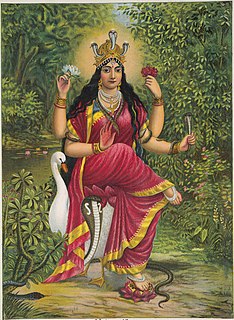
Manasa is a Hindu goddess of snakes, worshipped mainly in Bengal, Jharkhand, Lower Assam and other parts of northeastern India and in Uttarakhand chiefly for the prevention and cure of snakebite and also for fertility and prosperity. Manasa is the sister of Shesha and Vasuki, king of Nāgas (serpents) and wife of sage Jaratkaru. She is also the mother of the sage Astika. She is also known as Vishahari, Nityā (eternal) and Padmavati.

The Sri Sita Ramachandraswamy temple is a Hindu temple dedicated to Rama, a prominent avatar of the god Vishnu. It is located on the banks of the Godavari River in the town of Bhadrachalam in east Telangana, India. Often simply referred to as Bhadrachalam or Bhadradri, the temple is considered one of the Divya Kshetrams of Godavari and is also revered as Dakshina Ayodhya.

Dharmaraj is a Hindu deity of death and justice, worshipped by villagers in the traditional Rarh region in the present day Indian state of West Bengal as one of their special village gods. He is represented by a shapeless stone daubed with vermillion and is normally placed under a tree or placed in the open, but sometimes enshrined in a temple. The worship takes place in the months of Baisakh, Jaistha and Asarh on the day of full moon and sometimes on the last day of Bhadro. Dharmaraj is worshipped mainly all castes.
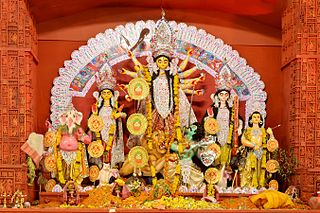
Ayudha Puja is a part of the Navratri festival, a Hindu festival that is traditionally celebrated in India. It may be translated to “worship of Instruments”. It is celebrated in Karnataka as “Ayudha Puje” .Tamil Nadu as Ayudha Pujai, in Telangana and Andhra Pradesh as Aayudha Pooja, in Kerala as Ayudha Puja, "Astra Puja" or "Ayudha Puja" in Odisha, "Shastra Puja" or "Ayudha Puja/ Khande Navami" in Maharashtra, and in Karnataka as “Ayudha Puje”. The festival falls on the tenth day of the bright half of Moon's cycle of 15 days in the month of September/October, and is popularly a part of the Dasara or Navaratri or Durga Puja or Golu festival. On the tenth day of the Dasara festival, weapons and tools are worshipped. In Karnataka, the celebration is for the slaying of the demon king Mahishasura by the goddess Durga. While the Navaratri festival is observed all over the country, the festivity that is widely marked as Ayudha Puja possesses slight variations of worship and practices across India.
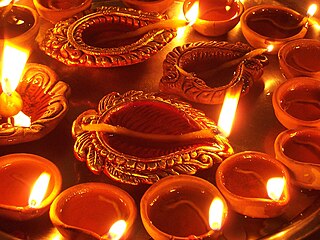
Worship in Hinduism is an act of religious devotion usually directed to one or more Hindu deities. A sense of Bhakti or devotional love is generally invoked. This term is probably a central one in Hinduism, but a direct translation from the Sanskrit to English is difficult. Worship takes a multitude of forms depending on geography and language. Worship is not confined to any place of worship, and it will often incorporate personal reflection, music, dance and poetry. Hindus usually perform worship in temples or at home to achieve some specific end or to integrate the body, mind and spirit. The aim is to live a pure life in order to help the performer reincarnate into a higher being.
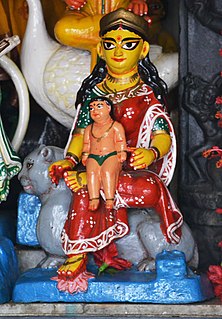
Shashthi or Shashti is a Hindu goddess, venerated in Nepal and India as the benefactor and protector of children. She is also the deity of vegetation and reproduction and is believed to bestow children and assist during childbirth. She is often pictured as a motherly figure, riding a cat and nursing one or more infants. She is symbolically represented in a variety of forms, including an earthenware pitcher, a banyan tree or part of it or a red stone beneath such a tree; outdoor spaces termed shashthitala are also consecrated for her worship. The worship of Shashthi is prescribed to occur on the sixth day of each lunar month of the Hindu calendar as well as on the sixth day after a child's birth. Barren women desiring to conceive and mothers seeking to ensure the protection of their children will worship Shashthi and request her blessings and aid. She is especially venerated in eastern India.

Tulasi Chaura,Tulasi Vrindavan, Tulasi Brundavanam or Tulasi Thara is a small podium-like stone or cement construction in front of traditional Hindu houses, housing the sacred Tulasi plant.
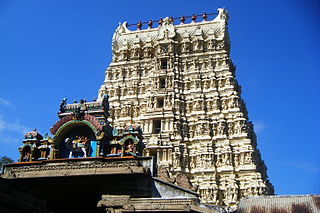
Papanasanathar Temple in Papanasam, a village in Tirunelveli district in the South Indian state of Tamil Nadu, is dedicated to Hindu god Shiva. It is located 60 km from Tirunelveli. Constructed in the Dravidian architecture, the temple has three precincts. Shiva is worshipped as Papanasanathar and his consort Parvathi as Ulagammai.

KallalagarTemple is a Hindu temple dedicated to Vishnu in Alagar Koyil, a village in Madurai district in the South Indian state of Tamil Nadu. Constructed in the Dravidian style of architecture, the temple is glorified in the Divya Prabandha, the early medieval Tamil canon of the Alvar saints from the 6th–9th centuries CE. It is one of the 108 Divyadesam dedicated to Vishnu, who is worshiped as Kallalagar and his consort Lakshmi as Thirumagal. This temple is called as Thirumaliruncholai in Sangam literatures and Naalayira Divya Prabandham sung by Tamil Alvar saints.
Kori Kambla is a distinct agriculture-based celebration in Tulunadu. This refers to a kind of collective ploughing and planting on a fixed day for the enelu cultivation. A general race of buffaloes is known as kori Kambala. It highlights the principle of cooperation in cultivation which, in turn, helped in moulding the community life of the people of Tulunadu. It is a collectively executed task in which every household participates with men and animals. Celebrated in the traditional way in the household family here every year. The villagers and the Guttinamane family celebrates the ritual with pomp and gaiety.














